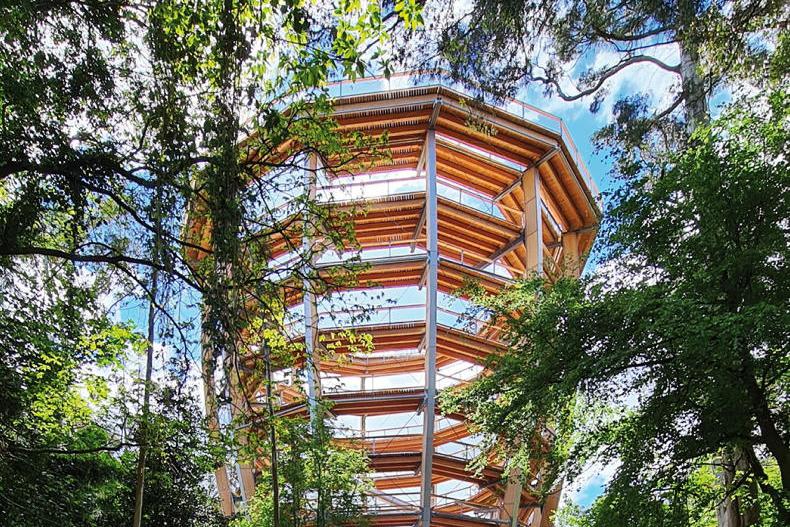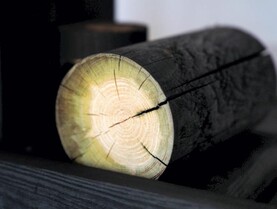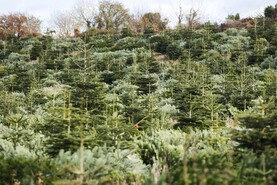Two Coillte construction projects in Avondale, Co Wicklow dominated last week’s Wood Awards Ireland in Farmleigh House, Dublin. The spectacular Treetop Walk emerged as the outright winner. Completed by EAK Ireland Treetop Walks from homegrown timber, it was ranked ahead of 14 shortlisted construction and design projects.
The 1.4km wooden walkway rises gradually to 23m, close to the forest canopy, and ends at a 38m viewing tower, which provides panoramic views of the Coillte Forest Park and Wicklow landscape. The walk is accessible to all ages, as it is designed so the gradient is never more than 6%. It is the first certified “Age Friendly” tourism attraction in the world.
“The innovative Treetop Walk, Avondale demonstrates what can be achieved using Irish-grown wood,” said Ciaran O’Connor, State Architect and chair of the Wood Awards Ireland judging panel. “Timber has the lowest embodied carbon of any mainstream building material, and this is recognised internationally as architects are now embracing timber frame and ‘mass timber’ as the most innovative and lowest carbon building systems today,” he added.
“The walk combines recreation with education as it explores the various strata within the forest and forest canopy,” said Aidan McGreevy of EAK. The project was also praised by the judging panel for its low carbon footprint, as 1,100m3 of Douglas fir and larch timber lock in 700t of carbon.
Large public building
Beyond the Trees by van Dijk Architects won the Large Public Building category award. The Coillte visitor centre in Avondale comprises a shop, café, exhibition space and pavilion. It is the first project in Ireland to use home-grown Sitka spruce for glulam (glued laminated timber).
Glulam is composed of parallel lengths of timber, glued together to provide long load-bearing structures – 25m in Avondale.

Beyond the Trees, Avondale, by van Dijk Architects, winner of Large-scale Public Buildings using Sitka spruce glulam. \ Shane Walsh
The building impressed the judges not only because of the quality of the design, but also because the timber was sourced locally, providing an environmentally friendly building material and low-carbon structure.
Small-scale building
The Forge in Schull, Co Cork, designed by Broadstone Architects, won the Small-scale Private Building category award. This building involved a total redesign of an existing building, which was extended over the years by piecemeal development.

The Forge, Schull, Co Cork, winner of Small-scale Building Project category by Broadstone Architects. \ Shantanu Starick
The design reconfigures the existing house around the historic forge. While wood is a major design element, the building also involves interplay between timber and other materials. Internally, exposed timber rafters contrast with exposed steel supporting the roof, while externally the upper light-timber elements contrast with stone and masonry elements.
The project used numerous types and species of timber, including DuraWood – a thermally modified hardwood – Siberian larch, Douglas fir, Birch plywood and Sitka spruce.
International winner
Woodland owners will find inspiration from the international winner House in the Woods, designed by Tierney Haines Architects.
This three-bedroom, 250m2 replacement house sits in a 16th-century woodland clearing in Surrey, overlooking a tributary of the river Arun. The clients were keen to find a way of living in the woods that celebrated the unique qualities of the place and a closeness to nature.

House in the Woods, Surrey, by Tierney Haines Architects. \ Photo: Tierney Haines Architects
Due to strict planning restrictions on replacement dwellings, height was limited, so the roof is flat. Air-tightness, insulation, and energy-use have been optimised with rainwater harvesting, while solar panels contribute to a near-zero energy building.
Local contractors
Hardwoods were harvested by local contractors and hauled by horses from the woodland. Seasoned on-site, the untreated oak was used for external cladding, while ash was used for internal joinery.
Furniture and special award
The Emma Table, designed by Stephen Tierney and made by Paul O’Brien, Model Furniture, won the Furniture award. Designed to fit a leather banquette, the objective was to achieve a light look with a solid feel, which the designer and maker achieved using American white oak.

Emma Table, designed by Stephen Tierney and made by Paul O'Brien, winner of Furniture award. \ Tierney Haines
The judging panel presented a special award to Cathal and Colm Campbell Glenfort Timber Engineering for their creative and innovative use of engineered wood in construction. The contribution of Glenfort was a key element in a number of major timber projects, including Beyond the Trees, Avondale.
Glenfort’s latest milestone building is the design, manufacture and installation of its own glulam factory in Dungannon, Co Tyrone. This sustainable structure has over 140m3 of glulam-timber, which locks in 114t of CO2.
Seven wood-design, research and furniture projects were shortlisted for the Third Level Student Wood award, which was won by Laura O’Toole, Technological University (TU), Dublin for exploring the role of wood in decarbonising the construction economy.
The Rotary Ireland Environment award was won by 19 students from TU, Dublin who designed and made 12 benches for the Seamus Heaney Walk in Devil’s Glen forest, Co Wicklow.
The students specified and sourced Douglas fir timber in Co Wicklow, which was sawn by Pat Staunton in Glenealy. They visited the forest and met with local stakeholders, including Coillte’s forest manager and recreation personnel, before holding a design competition. The students made the seats over a two-year period, despite COVID-19 constraints.
In addition to Ciaran O’Connor, the Wood Awards’ judging panel comprised: Karen McEvoy, Bucholz McEvoy; Seán Harrington, Seán Harrington Architects; Maria Couchman, Design & Crafts Council Ireland; Des O’Toole, Forest Industries Ireland (FII); and Neil Kerrigan, Enterprise Ireland (EI).
Sean Fitzgerald, district governor, Rotary Ireland thanked the Rotary Environment judges Prof. Mary Ryan, University of Galway, John McLoughlin, Society of Irish Foresters, Tom Kent, South East TU and Des O’Toole, Forest Industries Ireland (FII).
The awards were sponsored by FII, Department of Agriculture, Food and the Marine, EI and supported by the Royal Institute of the Architects of Ireland, Design & Crafts Council Ireland and the Society of Irish Foresters.
Two Coillte construction projects in Avondale, Co Wicklow dominated last week’s Wood Awards Ireland in Farmleigh House, Dublin. The spectacular Treetop Walk emerged as the outright winner. Completed by EAK Ireland Treetop Walks from homegrown timber, it was ranked ahead of 14 shortlisted construction and design projects.
The 1.4km wooden walkway rises gradually to 23m, close to the forest canopy, and ends at a 38m viewing tower, which provides panoramic views of the Coillte Forest Park and Wicklow landscape. The walk is accessible to all ages, as it is designed so the gradient is never more than 6%. It is the first certified “Age Friendly” tourism attraction in the world.
“The innovative Treetop Walk, Avondale demonstrates what can be achieved using Irish-grown wood,” said Ciaran O’Connor, State Architect and chair of the Wood Awards Ireland judging panel. “Timber has the lowest embodied carbon of any mainstream building material, and this is recognised internationally as architects are now embracing timber frame and ‘mass timber’ as the most innovative and lowest carbon building systems today,” he added.
“The walk combines recreation with education as it explores the various strata within the forest and forest canopy,” said Aidan McGreevy of EAK. The project was also praised by the judging panel for its low carbon footprint, as 1,100m3 of Douglas fir and larch timber lock in 700t of carbon.
Large public building
Beyond the Trees by van Dijk Architects won the Large Public Building category award. The Coillte visitor centre in Avondale comprises a shop, café, exhibition space and pavilion. It is the first project in Ireland to use home-grown Sitka spruce for glulam (glued laminated timber).
Glulam is composed of parallel lengths of timber, glued together to provide long load-bearing structures – 25m in Avondale.

Beyond the Trees, Avondale, by van Dijk Architects, winner of Large-scale Public Buildings using Sitka spruce glulam. \ Shane Walsh
The building impressed the judges not only because of the quality of the design, but also because the timber was sourced locally, providing an environmentally friendly building material and low-carbon structure.
Small-scale building
The Forge in Schull, Co Cork, designed by Broadstone Architects, won the Small-scale Private Building category award. This building involved a total redesign of an existing building, which was extended over the years by piecemeal development.

The Forge, Schull, Co Cork, winner of Small-scale Building Project category by Broadstone Architects. \ Shantanu Starick
The design reconfigures the existing house around the historic forge. While wood is a major design element, the building also involves interplay between timber and other materials. Internally, exposed timber rafters contrast with exposed steel supporting the roof, while externally the upper light-timber elements contrast with stone and masonry elements.
The project used numerous types and species of timber, including DuraWood – a thermally modified hardwood – Siberian larch, Douglas fir, Birch plywood and Sitka spruce.
International winner
Woodland owners will find inspiration from the international winner House in the Woods, designed by Tierney Haines Architects.
This three-bedroom, 250m2 replacement house sits in a 16th-century woodland clearing in Surrey, overlooking a tributary of the river Arun. The clients were keen to find a way of living in the woods that celebrated the unique qualities of the place and a closeness to nature.

House in the Woods, Surrey, by Tierney Haines Architects. \ Photo: Tierney Haines Architects
Due to strict planning restrictions on replacement dwellings, height was limited, so the roof is flat. Air-tightness, insulation, and energy-use have been optimised with rainwater harvesting, while solar panels contribute to a near-zero energy building.
Local contractors
Hardwoods were harvested by local contractors and hauled by horses from the woodland. Seasoned on-site, the untreated oak was used for external cladding, while ash was used for internal joinery.
Furniture and special award
The Emma Table, designed by Stephen Tierney and made by Paul O’Brien, Model Furniture, won the Furniture award. Designed to fit a leather banquette, the objective was to achieve a light look with a solid feel, which the designer and maker achieved using American white oak.

Emma Table, designed by Stephen Tierney and made by Paul O'Brien, winner of Furniture award. \ Tierney Haines
The judging panel presented a special award to Cathal and Colm Campbell Glenfort Timber Engineering for their creative and innovative use of engineered wood in construction. The contribution of Glenfort was a key element in a number of major timber projects, including Beyond the Trees, Avondale.
Glenfort’s latest milestone building is the design, manufacture and installation of its own glulam factory in Dungannon, Co Tyrone. This sustainable structure has over 140m3 of glulam-timber, which locks in 114t of CO2.
Seven wood-design, research and furniture projects were shortlisted for the Third Level Student Wood award, which was won by Laura O’Toole, Technological University (TU), Dublin for exploring the role of wood in decarbonising the construction economy.
The Rotary Ireland Environment award was won by 19 students from TU, Dublin who designed and made 12 benches for the Seamus Heaney Walk in Devil’s Glen forest, Co Wicklow.
The students specified and sourced Douglas fir timber in Co Wicklow, which was sawn by Pat Staunton in Glenealy. They visited the forest and met with local stakeholders, including Coillte’s forest manager and recreation personnel, before holding a design competition. The students made the seats over a two-year period, despite COVID-19 constraints.
In addition to Ciaran O’Connor, the Wood Awards’ judging panel comprised: Karen McEvoy, Bucholz McEvoy; Seán Harrington, Seán Harrington Architects; Maria Couchman, Design & Crafts Council Ireland; Des O’Toole, Forest Industries Ireland (FII); and Neil Kerrigan, Enterprise Ireland (EI).
Sean Fitzgerald, district governor, Rotary Ireland thanked the Rotary Environment judges Prof. Mary Ryan, University of Galway, John McLoughlin, Society of Irish Foresters, Tom Kent, South East TU and Des O’Toole, Forest Industries Ireland (FII).
The awards were sponsored by FII, Department of Agriculture, Food and the Marine, EI and supported by the Royal Institute of the Architects of Ireland, Design & Crafts Council Ireland and the Society of Irish Foresters.










 This is a subscriber-only article
This is a subscriber-only article











SHARING OPTIONS: